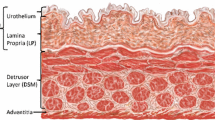Abstract
Objective: Collagen fibers impart tensile strength and transfer tension from bladder smooth muscle cells. We have previously shown that fibrotic bladders are characterized by an increased type III:type I collagen ratio. To determine the effect of decreased type III collagen on bladder function, type III collagen-deficient mice (COL3A1) were studied physiologically.Methods: Bladders from wild-type (+/+) and heterozygous (+/−) COL3A1 mice were biochemically characterized to determine total collagen (hydroxyproline analysis) and collagen subtype concentration (cyanogen bromide digestion and ELISA). Alterations in collagen fiber diameter were assessed by electron microscopy. Bladder muscle strips were used to assess physiologic function. Results: Hydroxyproline content decreased in heterozygous bladders, which had 50% less type III collagen. Wild-type bladders had a biphasic distribution of collagen fiber sizes, whereas heterozygous bladder collagen fibers spanned a broad range. Physiologically, there were no differences in contractile responses between wild-type and heterozygotes when stimulated with ATP, carbachol or KCl, indicating normal contraction via purinergic and muscarinic receptors, and in response to direct membrane depolarization. In contrast, tension generation in heterozygotes was decreased after field stimulation (FS), indicating decreased synaptic transmission. Length–tension studies showed that the heterozygote muscle strips generated less tension per unit length, indicating that they were more compliant than wild-type controls. Conclusions: Critical levels of type III collagen appear to be a requirement for normal bladder tension development and contraction. Our data show that a decrease in the type III:type I collagen ratio, and altered fiber size, results in a more compliant bladder with altered neurotransmitter function.
Similar content being viewed by others
References
Fleischmajer R, MacDonald ED, Perlish JS, Burgeson RE, Fisher LW: Dermal collagen fibrils are hybrids of type I and type III collagen molecules. J Struct Biol 105: 162–169, 1990
Derwin KA, Soslowsky LJ: A quantitative investigation of structure–function relationships in a tendon fascicle model. J Biomech Eng 121: 598–604, 1999
Liu X, We H, Byrne M, Krane S, Jaenisch R: Type III collagen is crucial for collagen I fibrillogenesis and for normal cardiovascular development. Proc Natl Acad Sci USA 94: 1852–1856, 1997
Chang SL, Chung JS, Yeung MK, Howard PS, Macarak EJ: Roles of the lamina propria and the detrusor in tension transfer during bladder filling. Scand J Urol Nephrol 201S: 38–45, 1999
Chang SL, Howard PS, Koo HP, Macarak EJ: Role of type III collagen in bladder filling. Neurol Urodynam 17: 135–145, 1998
Macarak EJ, Howard PS: The collagens and their urologic significance. Scand J Urol Nephrol 184S: 25–33, 1997
Deveaud C, Macarak EJ, Kucich U, Ewalt DH, Abrams WR, Howard PS: Molecular analysis of collagen in non-compliant bladders. J Urol 160: 1518–1527, 1998
Ewalt DH, Howard PS, Blyth B, Snyder H, Duckett J, Levin R, Macarak E: Is lamina propria matrix responsible for normal bladder compliance? J Urol 148: 544–549, 1992
Howard PS, Renfrow D, Schechter NM, Kucich U: Mast cell chymase is a possible mediator of neurogenic bladder fibrosis. Neurourol Urodynam 23: 374–382, 2004
Brown S, Worsfold M, Sharp C: Microplate assay for the measurement of hydroxyproline in acid-hydrolyzed tissue samples. Biotechniques 30: 38–42, 2001
Neuman R, Logan M: The determination of collagen and elastin in tissues. J Biol Chem 186: 549–556, 1950
Baskin LS, Constantinescu S, Duckett JW, Snyder HM, Macarak E: Type III collagen decreases in normal fetal bovine bladder development. J Urol 152: 688–691, 1994
Linsenmayer TF, Fitch JM, Gross J, Mayne R: Are collagen fibrils in the developing avian cornea composed of two different collagen types? Evidence from monoclonal antibody studies. Ann NY Acad Sci 460: 232–245, 1985
Lai HH, Boone TB, Yang G, Smith CP, Kiss S, Thompson TC, Somogyi GT: Loss of caveolin-1 expression is associated with disruption of muscarinic cholinergic activities in the urinary bladder. Neurochem Int 45: 1185–1193, 2004
Sanes J: The basement membrane/basal lamina of skeletal muscle. J Biol Chem 278: 12601–12604, 2003
Gabella G: Cells and cell junctions in the muscle coat of the bladder. Scand J Urol Nephrol 184: 3–6, 1997
Gingras J, Spicer J, Altares M, Zhu Q, Kuchel GA, Ferns M: Agrin becomes concentrated at neuroeffector junctions in developing rodent urinary bladder. Cell Tissue Res 320: 115–125, 2005
Bixby JL: Collagen synthesis inhibition reduces clustering of heparin sulfate proteoglycan and acetylcholine receptors but not agrin or p65, at neuromuscular contacts in vitro. J Neurobiol 26: 262–272, 1995
Fu W-M, Liou H-H, Wang C-L: Collaboration of fibronectin matrix and neurotrophin in regulating spontaneous transmitter release at developing neuromuscular synapses in Xenopus cell cultures. Neurosci Lett 300: 115–119, 2001
Liou H-H, Lin W, Liou H-C, Huang T-F, Fu W-M: Modulation of protein kinase A activation by fibronectin matrix proteins at developing neuromuscular synapses in Xenopus laevis cell cultures. Mol Pharmacol 60: 348–354, 2001
Author information
Authors and Affiliations
Corresponding author
Rights and permissions
About this article
Cite this article
Stevenson, K., Kucich, U., Whitbeck, C. et al. Functional changes in bladder tissue from type III collagen-deficient mice. Mol Cell Biochem 283, 107–114 (2006). https://doi.org/10.1007/s11010-006-2388-1
Received:
Accepted:
Issue Date:
DOI: https://doi.org/10.1007/s11010-006-2388-1




